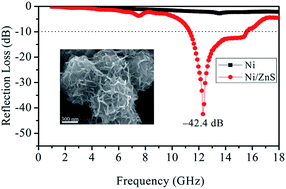Facile synthesis of crumpled ZnS net-wrapped Ni walnut spheres with enhanced microwave absorption properties
Abstract
Controllable magnetic–dielectric hybrids with cores of walnut-like Ni and shells of ultra-thin and crumpled ZnS nets have been successfully synthesized by a facile two-step approach. The morphology, microstructure and microwave absorption properties of the as-synthesized core–shell Ni/ZnS composites were investigated by scanning electron microscopy, energy dispersive X-ray spectroscopy, X-ray diffraction, transmission electron microscopy and network analysis. The shapes and microwave absorption properties of Ni/ZnS can be tuned by the hydrothermal temperatures. The core–shell Ni/ZnS composites present significantly enhanced microwave absorption compared with pristine Ni walnuts. When the reaction temperature was 60 °C, the reflection loss (RL) could be as low as −42.4 dB at 12.3 GHz. Moreover, the effective bandwidth (RL < −10 dB) can be recorded in the 11.3–15.6 GHz range with the absorber thickness of only 2.2 mm. The excellent microwave absorption properties were attributed to impedance match, the synergetic effect between the dielectric loss and magnetic loss, interfacial relaxation and conduction loss of unique cross-linked ZnS shells. These results suggest that the as-synthesized crumpled ZnS net-wrapped Ni composites may be an attractive candidate for microwave absorption application.


 Please wait while we load your content...
Please wait while we load your content...